TELEVISION PROGRAMS IN JAPAN

Japan television programming is a mix of office lady melodramas, samurai movies, karoake sing-a-longs, doe-eyed animation characters, news programs, travel documentaries, late night soft-core porn, and variety shows and quiz shows with the latest singing idols and cute boy sensations. The commercial are often silly and entertaining. Information on the latest earthquakes is broadcast almost instantaneously.
Other common sights on Japanese airwaves include: 1) shows with people eating and talking about food; 2) silly shows with people goofing off in various ways such as dressing in Velcro suits and leaping off trampolines onto Velcro targets; and 3) detailed analyses and long discussions, with a lot of charts and diagrams, on mundane topics.
Fuji Television is one of Japan’s largest television and film producers. Not unlike the Fox Network in the United States, it is known for loud, trashy, obnoxious, low-brow shows. It fills many of its time slots with quiz shows with ditsy celebrities that seem perplexed by the dumbest questions and are infamous for their ridiculous answers. Other Japanese television stations have copied the Fuji format.

Television critic Wm. Penn wrote in the Daily Yomiuri, the Japanese television industry “have tossed a rubbish barrel of programming at us and presided over a gross lowering of standards that has caused a whole new generation of viewers to be raised on a diet of the most vapid junk TV. Like junk food, it numbs the taste buds and after a while, one can no longer appreciate delicate flavors and more hearty, healthy fare.”
Travel shows are common. Foreign language instruction shows are offered in nine languages. And marathons are shown in their entirety, uncut. During the summer there are lots of baseball games. Sometimes the same game is on three channels but viewers are unable to see the end as the stations cut to way to other programs before the game is finished.
The cost per episode of a high profile samurai drama is ¥61 million. By contrast a cooking show costs only ¥1.7 million per episode to make. The costs include fees paid to people who appear in the show, script costs, personal expenses and equipment costs. Sometimes as much as half of the costs for a samurai dramas is for sets.
Japanese television shows have not sold well abroad. In 2008, they earned less than $100 million, considerably less than what South Korean television shows earned.
Japanese television commercials feature lots of silly dances, young girls and cut pets; are paced by lightning quick cuts and editing; and sometimes make fun of Tokyo posturing and the Kansai dialect,
Websites and Resources
Good Websites and Sources: Funny Japanese TV Programs mynippon.com ; RobPongi Television Blog robpongi.com ; 1990s Article on Japanese Programs Shown Abroad pdf file rdarc.itakura.toyo.ac. Ten Strange Japanese YouTube Videos listicles.thelmagazine.com ; Weird Japanese Games Shows You Tube ; Iron Chef Japan fineliving.com ; Academic Article on Korean Dramas in Japan allacademic.com
Links in this Website: MEDIA, RADIO, NEWSPAPERS AND TELEVISION IN JAPAN Factsanddetails.com/Japan ; TELEVISION PROGRAMS IN JAPAN Factsanddetails.com/Japan ; CHILDREN’s TELEVISION SHOWS IN JAPAN Factsanddetails.com/Japan ; INTERNET IN JAPAN Factsanddetails.com/Japan ; COMMUNICATIONS IN JAPAN Factsanddetails.com/Japan ; CELL PHONES IN JAPAN Factsanddetails.com/Japan ; USES OF CELL PHONES IN JAPAN Factsanddetails.com/Japan ;
Good Websites and Sources: Good Photos at Japan-Photo Archive japan-photo.de ; Japanese Newspapers and Media sabotenweb.com ; The Evolution of TV in Japan www.nhk.or.jp ; Media and Communications in Japan japanesestudies.org.uk ; Media Intimidation in Japan japanesestudies.org.uk ; Statistical Handbook of Japan Media Section stat.go.jp/english/data/handbook ; 2010 Edition stat.go.jp/english/data/nenkan ; News stat.go.jp
Japanese English-Language Newspapers: Daily Yomirui yomiuri.co.jp/dy ; Japan Times japantimes.co ; Asahi Shimbun with the International Herald Tribune asahi.com ; Mainichi Daily in English mdn.mainichi.jp ; Japanese Television Stations NHK nhk.or.jp ; Nippon Television Network (NTV) ntv.co.jp ; Fuji Network fujitv.co.jp/en ; TBS (Tokyo Broadcasting System) News (in Japanese) news.tbs.co.jp ; TV Asahi company.tv-asahi.co ; CNN on Japan topics.cnn.com ;
Radio Streaming Radio on DMOZ DMOZ ; DVDs Japanese, Chinese and Korean CDs and DVDs at Yes Asia yesasia.com ; Japanese, Chinese and Korean CDs and DVDs at Zoom Movie zoommovie.com ; CD Japan cdjapan.co.jp ;
Japanese Television Personalities
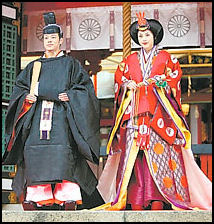
Noriko Fujiwara's
$5 million wedding There is a contingent of about 20 or 30 entertainers that appear on television all the time. They include actors, singers, politicians and comedians as well as a pair of sister famous for their big tits, a former yakuza boss, a young American black man who sings enka songs he learned from his Japanese grandmother, and Debbie, the ex-wife of Sukarnao, the late leader of Indonesia.
Many popular entertainers frequently move from one sector of the entertainment industry to another, Daily Yomiuri Japanese television critic Wm. Penn wrote: “too numerous to mention are the idol and TV personalties who have morphed into singers, actors, comedians and talk show regulars...Variety show hosts turn into news anchors...Retired sports figures get plenty of exercise as reporters and variety show regulars. Politicians and former bureaucrats can morph into commentators or clowning commentators...while a long list of comedians have become politicians.”
The Japanese are obsessed with female celebrities. A female television reporter named Mona Yamamoto lost her job after she was caught on camera kissing a politician. Afterwards her celebrity quotient soared and she became a regular on variety shows and then used that position to get a job as newscaster. Noriko Fujiwara is a former beauty pagent winner who shamelessly exploits herself and is on television a lot.
Popular Television Programs in Japan
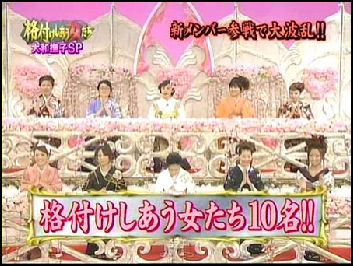
London Hearts
popular in late 2000s “Strange Things About the Japanese” is a show that was popular in the late 1990s. It features a group of a 100 foreigners, from a variety of countries, all of them fluent in Japanese, who were asked their opinions on controversial topics like racism and promiscuity as they relate to Japanese and Japan. The opinionated foreigners expressed opinion that were unsettling to Japanese . Sometimes Jerry-Springer-Show like arguments and fights broke out. The show was very popular for a while but people got sick of it. It made a star though of a 30-something graduate student from Benin named Rufin Zomahoun.
Murder mysteries are also very popular. They differ from their American counterparts in that guns are almost never the murder weapons and car chases are almost nonexistent. The favored murdered weapons are knives, poisons and strangulation. Sleuths that solve the mysteries often get around in trains and taxis rather than their own cars. They are usually journalists, geisha, inn owners, teachers or doctors rather than police or detectives. The perpetrators are usually close to the victims and are out to get revenge.
The highest rated show ever was NHK “Red-and-White Song Contest” in 1963, with a rating of 81 percent. The show, which is still held annually in the evening of New Year's Eve features top singers form the previous the year as well as favorites from years past placed on red and white teams. K-1, a brutal style of kickboxing, and Pride, a similar sport, draw huge audiences on television and have become as much of a fixture of New Years as the traditional holiday musical show,
Kohaku Uta Gassen, or the Red and White Singing Contest. is broadcast every year in Japan from 7:15pm to 11:45pm on December 31. The show is considered one of the leading musical platforms in the country and garnered an average 37.4 percent viewership last year according to Japan's ratings tracker Video Research. This will be the 62nd edition of Kohaku Uta Gassen, which rounds up the most popular Japanese domestic musical acts every year for a good-natured New Year's Eve singing contest in which the women (red) compete against the men (white). Kohaku is always shot live for the performers in Japan and the show encourages international performers, even when overseas, to perform live. There is usually one international artist selected to perform every year.
There are a lot of shows with comedians doing stand up routines and celebrities engaging in silly activities. “Super Friday Special” is a popular show featuring celebrities being asked stupid question by host and then doing karaoke versions of other people's songs. “Music Station”, another Friday night fixture, is like a Japanese version of “Top of the Pops” or “American Bandstand”. It has been around for decades.
Many films and television shows are inspired by manga series. Sometimes several films and television shows are inspired by the same series. Even in Taiwan, a number of Japanese manga have been made into television dramas.
Some Japanese television dramas run quite a long time. TBS’s classic home drama “Wataru Seken wa Oni Bakari” ended in September 2011 after a 500 episode run that continued for 10 seasons over 21 years. Wm. Penn wrote in the Daily Yomiuri, “The drama began back in 1990, with Daikichi (Takuya Fujioka) and Setsuko Okakura (Hisano Yamaoka) planning to remodel their home so they could spend their retirement years running a Japanese restaurant out of their former living room. Ever since then, Daikichi has been busy dealing with the problems of the couple's five daughters--Yayoi, Satsuki, Fumiko, Yoko and Nagako--and their husbands, kids and troublesome mother-in-laws.” [Source: Wm. Penn, Daily Yomiuri, September 23, 2011]
“Wataru Seken has continued for so long that the actors who played the original Daikichi and Setsuko have both died. When Yamaoka became ill in Season 4, her character was killed off--dying of a heart attack in New York during her first vacation abroad. When Fujioka suddenly passed away, Ken Utsui took over the role. He was such a natural that the transition to a mellower, calmer Daikichi was surprisingly smooth.”
Filmmaker Takeshi Kitano is also one of Japan's most familiar television personalities. Known by the stage name of Beat Takeshi, he regularly appears in seven or eight different television shows a week.
Many of his extremely popular television shows are notorious for their cruel, humiliating and violent treatment of guests. “Super Jockey”, for example, featured guests receiving painful blows by karate experts, forced to sample disgusting flavors of ice cream, and attacked and stripped to their undergarments by members of the opposite sex. Hosted by Kitano, the show ended with several women, each representing a sponsor, being immersing in scalding hot water, with the sponsor of the woman who stays in the longest (usually only three or four seconds) being allowed to do a commercial.
Takeshi occupies over seven hours of television programming a week.Among the shows that Kitano has created are “We Are Wild and Crazy Guy”, which many people have said was outrageously funny; “Anyone Can be Picasso”, which gives little known artists a chance to show their stuff on television; and “Strong Things About the Japanese”.
Television critic Wm. Penn wrote in the Daily Yomiuri, “Beat Takashi's most enduring and far-reaching contribution to the entertainment world just might be a funny little reality game show he launched in 1986 called “Assault on Takeshi’s Castle” , in which dozens of challengers ran an obstacle course for a chance to face off against Beat in a water gun battle on golf carts. It’s been off the air in Japan for over 20 years, but TBS has successfully licensed the concept in 159 countries since then. The latest recruit was Serbia’s PRVA in 2010.”
Japanese Food and Cooking Shows

Smap Cooking show Typical food shows have celebrities trying out dishes made by famous chefs and ooing and awing over how delicious they are. There is one show where all the guests eat something at very expensive at a restaurant and guess how much it costs. The loser, the person whose guess is farthest away from the real price, has to pay the bill. In another show celebrity guest eat several dishes, including one they don’t like, with the objective of fooling guests and make them guess incorrectly which food the celebrity doesn’t like.
Cooking and eating shows are very popular in Japan. One of the most popular shows, “Iron Chef”, was one of the top shows in 1990s and later became a hit on the Food Network in the United States. Staged in a domed "kitchen stadium," the show feature a competition between a challenger chef and one of the show's resident chefs. Each is given an hour to prepare a dish with a main ingredient that there are not informed of before the show. Their creations are judged by a cruel panel of critics and a winner is announced.
The cooks perform in a "Kitchen Stadium" with 400 ingredients. The main ingredient is announced by the show’s host who bangs the Gong of Fate signaling the chefs to begin their work while excited sports-style play-by-play announcers describe what they are doing and provide analysis.
The chefs often work at a furious pace, tripping over TV wires, cutting themselves with their knives as they make ice from oysters and prepare milk-marinated carp. One time a chef cooked electric eel. Another time a chef extracted the essence of lobster to flavor asparagus and then the threw the lobster away. There are no cash prizes. Just the prestige of appearing.
There are also a number of show that center around searches for most delicious bowl or noodles and innovative sushi.
Sex and Dating on Television in Japan
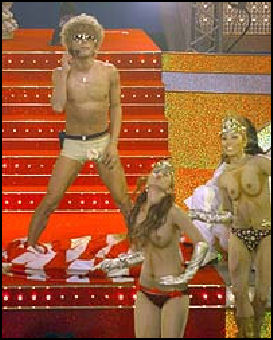
Exposed breasts, female humiliation, and frank discussions about sexual topics are fixtures of late night Japanese television. Programs after 11:00pm include shows with men in porno shops talking about new video releases (and showing their graphic covers) with embarrassed, giggling young women; movies that blur out the genital areas but show everything else; and game shows filled with close-ups of the breasts and crotch areas of bikini-clad women.
Late night shows that have appeared over the years have included “I'm Sorry For My Nice Body”, featuring bikini-clad girls talking about themselves and their bodies; “Kiss Me in a Bathing Suit”, with women, sometimes in only half a bathing suit, kissing men in front of a hooting and howling audience; and “Look for Big Breasts”, with well-endowed females personalities explaining how they take care of their breasts or how they made them so big. The latter employed reporters who searched around Japan for large-breasted women, who are willing to expose them on national television.
Films with sex and violence and foul language are broadcast uncut during prime time on major networks. Some times sex and cutsiness are mixed. One show feature nude women in a hot spring singing the Mickey Mouse Club song.
Dating and romance game shows have been a fixture of Japanese television for some time. Monta Mino has hosted several of them. The earliest dating show “Panchi di Deito” from the 1970s had a curtain between the daters and datees was very similar to the “Dating Game”. A popular game n the 1980s featured five guys and five girls with buttons. If Guy 1 and Girl 3 chose each other after answering a series of questions making a match was easy but of Guy 1 chose Girl 3 and Girl 4 chose Guy 1 then things became more complicated. In the 1990s dating travel shows were popular. In the 2000s a show with a prospective bride living separately with two prospective grooms in three-night-four-day “mini-marriage and another with Japanese men talking about life with their foreign brides were popular.
“Mirai Nikki” (“Future Diary”), a show that paired up strangers, and told them to behave in accordance with a diary prepared in advance in hope they would fall in love. The show was well received at the Cannes international show for TV programs and was picked by companies in 16 countries including ABC-TV in the United States.
“London Hearts” is a degrading show that rates, ranks and denigrates women. It has been on the air for more than 15 years and consistently is one show parents least want their children to watch.
Weird Shows and Reality Shows on Japanese Television
Weird shows have included “Husband and Wife Fight”, featuring unhappily married couples going at each other in a boxing ring; “Bushman”, a semi-documentary with a bushman brought from Africa and let lose in Tokyo to see how well he survives; “Dr. Stinky”, a children’s show with a piece of talking excrement; “Akashiya Sanma’s Multinational Troop”, a variety show with a “Funky Foreigner” segment.
Reality TV has been a fixture of Japanese television for a long time. There are a lot of shows in which people are followed by a camera 24 hours day. One reason these shows have been so popular is that are cheap to make.
In 1998, a popular show featured a naked man, who was confined to apartment without anything except for some rice and told he wouldn't be released until he received 1 million yen (about $9000) worth of free goods. The man, nicknamed “Nasubi” ("Eggplant"), because he had a long face, spent almost a year in the room, writings 150 to 200 postcards a days for free good, until he achieved his goal and was released.
U.S. shows like “America's Funniest Home Movies, Animal Crack-Up Videos, Storm and Castle and Kind of the Mountain, The Big Moment” and “Future Diary” were all based on Japanese television shows.
The Japanese version of “Survivor” was filmed in on island in the island nation of Palau. The format was similar to the U.S. version. Sixteen contestants started and were eliminated one at a time by votes from the other contestants until one remained to claim the $100,000 prize.
“Wipeout”is an obstacle-course competition show on American television that was inspired by humiliating stunt shows in Japan. The debut of the show drew 10. 2 million viewers, Fox has imported a Japanese variety show called “Hole in the Wall” that features contestants trying to contort their bodies into awkward position to squeeze through a small hole as a wall approaches them on conveyor belt.
“I Survived a Japanese Game Show” is a real American reality TV show that was filmed in Japan before a Japanese studio audience that aired on ABC n the United States. One scene on the promotion shows a contestant being pulled from an eating challenge show and taken to the hospital. In this elimination game 10 competitors who had never been to Japan before vied for a grand prize of $250,000.
News broadcasts usually begin and end with a bow. One news broadcast uses a dog named Boonie as a reporter. Boonie began his career in 1994, the Year of the Dog, and was still going strong in 2000.
Many television shows feature a clueless woman who sits next to the male hosts and acts as his cheerleader — agreeing with everything he says, praising his intellect and laughing at his jokes — but offering no insights herself.
On the Japanese news media, Lenzaburo Oe wrote in the New York Times, "What is conveyed in our journalism is not a well-rounded portrait of real human being. Instead of profiles we resort to allegories: the irresponsibility of banks, the corruption of bureaucrats, the foolishness of politicians. Japanese journalist do no report on the life stories that spill out from around the frame of “significance.'"
In 2004, BBC Entertainment launched BBC Japan. Most of shows are BBC programs subtitled in Japanese.
NHK launched a 24-hour English news service in February 2009. Available via satellite, cable and the Internet, The service is an expansion of international broadcasts that began in 1995 and reached 80 million households world wide in 2008.
Sometimes television news reporters make their own news. A 24-year-old NHK reporter who covered crime was sentenced to seven years in jail for arson and attempted arson for setting fires between April and May 2005 in Otsu in Shiga Prefecture and Kishiwatda, Osaka Prefecture. He was arrested in November 2005 on suspicion for setting fire to a house under construction in the Osaka area and was suspected in 11 other attacks.
In June 2009, Japan’s TV Asahi said that it had a big scoop: a recent photographs of Kim Jong Un, the elusive 26-year-old son of North Korea leader of Kim Jong Il. The only problem is that it wasn’t him; it was a picture of a 40-year-old South Korea construction worker named Bae Seok-bum who runs a fortunetelling web site and happens to look a lot like Kin Long Il.
Irreverent News Shows in Japan
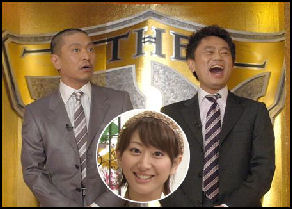
Although social satire is relatively common political satire is still somewhat are, and not nearly as developed as it is in the United States, Britain and other European countries. The most well-known political satirist, comedian Hinari Ota, draws equal amounts of laughs and criticism when he makes funs of the Prime Minister.
Hikari Ota is Japanese comedian famous for his “news” show in which he breaks taboos by poking fun at aging Japanese politicians and moribund politics. Once he told his studio audience, “It’s easy to spot them nodding away during parliamentary sessions. Sometimes they’re even dead!”
In the past, Japan’s traditional deference to authority prevented comedians from lampooning politicians and limited them to non political slapstick routines, The change is due as much to the politicians themselves who have let themselves open to lampooning with their involvement ins scandals and less than inspiring performances acting in the public good. Now many comedians broach formally off limits subjects to get shock-value laughs.
Freedom of expressions is a relatively new concept in Japan and still risky endeavor due to threats from right wing groups. Masuharu Ibaragi, an expert on politics and comedy ay the Tokyo University of Information Services told AP, “In Japan, doing political satire is like performing before an ethics committee. As a result, the media and entertainment industries use self-imposed restraint.”
Japanese Television Stars
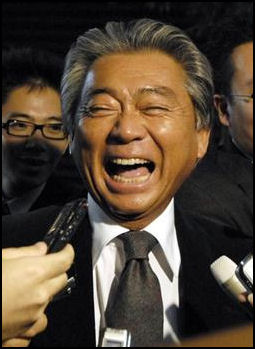
Monta Mino Japanese television host Monta Mino is recognized by the Guinness Book of records as being the world’s busiest TV show host. As of 2006, when he was 62, he appeared regularly on two TV programs that run from Monday to Thursday and another program on Saturday, performing for 21 hours and 42 minutes a week. On being so recognized Mina said, “I’m touched, as I want to spend my life talking.”
Young talent reportedly earns between ¥50,000 and ¥100,000 for television appearance and between ¥200,000 and ¥300,000 for appearances on popular variety shows. If they become regulars they can between ¥500,000 and ¥1 million. A superstar is defined as someone who gets ¥5 million for a variety show appearance. Young talent often comes and goes with surprising speed.
Top actors in popular 10-part dramas earn about ¥3 million per episode or ¥30 million for the entire series, get their own stylist and make up person and earn between ¥50,000 and ¥100,000 per episode if the series is rerun. Lesser actors earn between ¥500,000 and ¥800,000 per episode.
Commercial appearances by a popular actor can earn him or her ¥20 million to ¥30 million. Really big stars can earn more. Money can also be earned from book royalties, public appearances and speeches. One of the top earning actresses, Nanoka Matsushima, earned about $3.5 million in 2000. That year she has eight major commercial contracts and appeared in two major dramas. Her earnings were about half that of the highest paid pop singer.
Image Sources: You Tube, Japan Zone, Japan Sugoi, xorsyst blog, bionic bong, Bright Lights
Text Sources: New York Times, Washington Post, Los Angeles Times, Daily Yomiuri, Times of London, Japan National Tourist Organization (JNTO), National Geographic, The New Yorker, Time, Newsweek, Reuters, AP, Lonely Planet Guides, Compton’s Encyclopedia and various books and other publications.
Last updated January 2013
